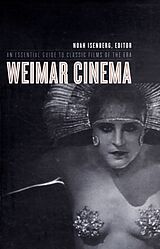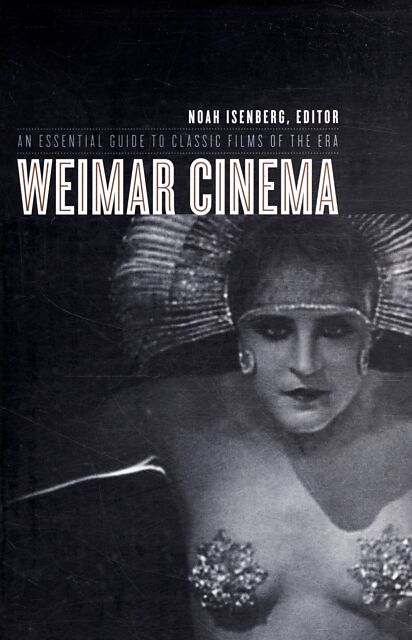Weimar Cinema
Einband:
Kartonierter Einband
EAN:
9780231130554
Untertitel:
An Essential Guide to Classic Films of the Era
Genre:
Kunst
Autor:
Noah (Book Review Editor, Film Quarterly Isenberg
Herausgeber:
Columbia University Press
Anzahl Seiten:
376
Erscheinungsdatum:
09.01.2009
ISBN:
978-0-231-13055-4
Informationen zum Autor Noah Isenberg is associate professor of University Humanities at Eugene Lang College-The New School, where he teaches literature, film, and intellectual history. He is the author, most recently, of Detour (British Film Institute, 2008). Klappentext Weimar Cinema focuses on the most widely taught films of the period: The Cabinet of Dr. Caligari, Nosferatu, The Joyless Street, Faust, Metropolis, Pandora's Box, and The Blue Angel, among others. Chapters address the technological advancements of each film; their production and place within the larger history of the German studio and Weimar cinema in general; the signature style of the film's director; the actors in the film and the rise of German stars; and the critical reception of the film both during and after its release. Genres discussed include horror, science fiction, melodrama, avant-garde and fantasy films. Readers can revisit the German debut of Greta Garbo, Louise Brooks, and Marlene Dietrich, the early careers of such directors as F. W. Murnau and Fritz Lang, and the visionary producers and cinematographers that cemented Weimar's reputation for unprecedented artistic innovation. Inhaltsverzeichnis Acknowledgments Introduction 1. Suggestion, Hypnosis, and Crime: Robert Wiene's The Cabinet of Dr. Caligari (1920), by Stefan Andriopoulos 2. Of Monsters and Magicians: Paul Wegener's The Golem : How He Came into the World (1920), by Noah Isenberg 3. Movies, Money, and Mystique, by Christian Rogowski 4. No End to Nosferatu (1922), by Thomas Elsaesser 5. Fritz Lang's Dr. Mabuse, the Gambler (1922): Grand Enunciator of the Weimar Era, by Tom Gunning 6. Who Gets the Last Laugh? Old Age and Generational Change in F. W. Murnau's The Last Laugh (1924), by Sabine Hake 7. Inflation and Devaluation: Gender, Space, and Economics in G. W. Pabst's The Joyless Street (1925), by Sara F. Hall 8. Tradition as Intellectual Montage: F. W. Murnau's Faust (1926), by Matt Erlin 9. Metropolis (1927): City, Cinema, Modernity, by Anton Kaes 10. Berlin, Symphony of a Great City (1927): City, Image, Sound, by Nora M. Alter 11. Surface Sheen and Charged Bodies: Louise Brooks as Lulu in Pandora's Box (1929), by Margaret McCarthy 12. The Bearable Lightness of Being: People on Sunday (1930), by Lutz Koepnick 13. National Cinemas / International Film Culture: The Blue Angel (1930) in Multiple Language Versions, by Patrice Petro 14. Coming Out of the Uniform: Political and Sexual Emancipation in Leontine Sagan's Mädchen in Uniform (1931), by Richard W. McCormick 15. Fritz Lang's M (1931): An Open Case, by Todd Herzog 16. Whose Revolution? The Subject of Kuhle Wampe (1932), by Marc Silberman Filmography Contributors Index...
Klappentext
Weimar Cinema focuses on the most widely taught films of the period: The Cabinet of Dr. Caligari, Nosferatu, The Joyless Street, Faust, Metropolis, Pandora's Box, and The Blue Angel, among others. Chapters address the technological advancements of each film; their production and place within the larger history of the German studio and Weimar cinema in general; the signature style of the film's director; the actors in the film and the rise of German stars; and the critical reception of the film both during and after its release. Genres discussed include horror, science fiction, melodrama, avant-garde and fantasy films. Readers can revisit the German debut of Greta Garbo, Louise Brooks, and Marlene Dietrich, the early careers of such directors as F. W. Murnau and Fritz Lang, and the visionary producers and cinematographers that cemented Weimar's reputation for unprecedented artistic innovation.
Inhalt
Acknowledgments
Introduction
1. Suggestion, Hypnosis, and Crime: Robert Wiene's The Cabinet of Dr. Caligari (1920), by Stefan Andriopoulos
2. Of Monsters and Magicians: Paul Wegener's The Golem: How He Came into the World (1920), by Noah Isenberg
3. Movies, Money, and Mystique, by Christian Rogowski
4. No End to Nosferatu (1922), by Thomas Elsaesser
5. Fritz Lang's Dr. Mabuse, the Gambler (1922): Grand Enunciator of the Weimar Era, by Tom Gunning
6. Who Gets the Last Laugh? Old Age and Generational Change in F. W. Murnau's The Last Laugh (1924), by Sabine Hake
7. Inflation and Devaluation: Gender, Space, and Economics in G. W. Pabst's The Joyless Street (1925), by Sara F. Hall
8. Tradition as Intellectual Montage: F. W. Murnau's Faust (1926), by Matt Erlin
9. Metropolis (1927): City, Cinema, Modernity, by Anton Kaes
10. Berlin, Symphony of a Great City (1927): City, Image, Sound, by Nora M. Alter
11. Surface Sheen and Charged Bodies: Louise Brooks as Lulu in Pandora's Box (1929), by Margaret McCarthy
12. The Bearable Lightness of Being: People on Sunday (1930), by Lutz Koepnick
13. National Cinemas / International Film Culture: The Blue Angel (1930) in Multiple Language Versions, by Patrice Petro
14. Coming Out of the Uniform: Political and Sexual Emancipation in Leontine Sagan's Mädchen in Uniform (1931), by Richard W. McCormick
15. Fritz Lang's M (1931): An Open Case, by Todd Herzog
16. Whose Revolution? The Subject of Kuhle Wampe (1932), by Marc Silberman
Filmography
Contributors
Index

Leider konnten wir für diesen Artikel keine Preise ermitteln ...
billigbuch.ch sucht jetzt für Sie die besten Angebote ...
Die aktuellen Verkaufspreise von 6 Onlineshops werden in Realtime abgefragt.
Sie können das gewünschte Produkt anschliessend direkt beim Anbieter Ihrer Wahl bestellen.
Loading...
Die aktuellen Verkaufspreise von 6 Onlineshops werden in Realtime abgefragt.
Sie können das gewünschte Produkt anschliessend direkt beim Anbieter Ihrer Wahl bestellen.
| # | Onlineshop | Preis CHF | Versand CHF | Total CHF | ||
|---|---|---|---|---|---|---|
| 1 | Seller | 0.00 | 0.00 | 0.00 |
